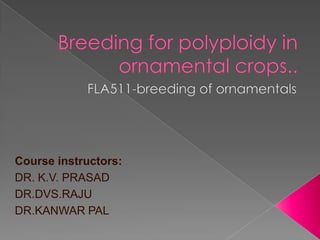
Course Instructors and Key Concepts in Polyploidy
- 1. Course instructors: DR. K.V. PRASAD DR.DVS.RAJU DR.KANWAR PAL
- 2. The presence of more than two paired sets of chromosomes. Numerical change in a whole set of chromosomes. Triploid (3N), tetraploid (4N), pentaploid (5N), hexaploid (6N)
- 3. The polyploidy is of two types Autopolyploidy more than two copies of a single genome. Allopolyploidy two or more genomes and each genome ordinarily present in 2 copies Autopolyploidy •within a species •multiplication of the same set of chromosomes • Induced artificially by colchicine Ex- Antirrhinum, Cosmos, Dimorphotheca
- 4. Traits in species , suited for induction of polypoidy- by dewey •Should have low CN •Economic part should be vegetative. •Should be cross- pollinated •Should be perennial in habitat. •Have ability to reproduce vegetatively.
- 5. Effect of polyploidy: 1.. Increased fruit weight, fruit size, seed size, crop load, flower size etc. 2.. Reduction in fertility (in odd ploidy level individuals). 3.. Change in growth pattern. 4.. Can be used to create higher diversity. 5.. Greater ability to colonize new habitats than diploid ancestors. 6.. increase blooming period (marigold, Begonia, ageratum)
- 6. Alloployploidy- •Chromosome doubling after hybridization of 2 sps • Interspecific polyploidy •Caused by hybridization followed by chromosome doubling e.g., AABB, AABBCC •To restore fertility in inter-specific crosses by spontaneous doubling of chromosome (Begonia, Impatians, Kalanchoe)
- 7. Haploidy: •Bears only one set of chromosomes •Haploids of higher plants are sterile •Producing pure homozygous lines for breeding programs. •Such plants are developed through a culture technique developed by Guha and Maheshwari • Gynogenic haploids
- 8. Application in crop improvement: -Tracing the origin of crop sps. -Speciation & evolution -Interspecific gene transfer. -As a bridging cross
- 9. Polyploidy in ornamental crops:
- 10. ROSE CN from 2n=14 to 56 Early miniatures diploid, later ones, tetraploid. Hybrid teas and flouribundas generally tetraploids Sterility of some diploid Interspecific hybrids arise through genomic differences, chromosome no may be expected to increase fertility.
- 11. Thus sterile diploid R. rugosa x wichuriana ‘Max Graf’ spontaneously produced a tetraploid seedling, R. kordessi Doubling of chromosome being tried For sterile hybrids & diploid species to avoid production of sterile triploids after cross with tetraploid cultivars. Polyploidy induced in species & F1 interspecific hybrids by colchicine to shoots of seedlings The frequency of tetraploid was low Chimerism complicating factor In-vitro, controlled application of spindle inhibitoRS
- 12. Gladiolus (x=15) South african species-diploid Eurasian and central African species-tetraploid Sterile triploids and pentaploids found Indicates diploid-tetraploid and tetraploid-hexaploid crosses Highest chromosome no G.communis Some tripoids and pentaploids are fertile Ferlite aneuploids
- 13. Dianthus species- • x = 15 (2n=30 to 180) •D. chinensis- tetraploid; D.caryophyllus-diploid •D. gratianopolitanus- both tetraploid and hexaploid •Many desirable plant characteristics related to plant ploidy levels • Mixoploidy in several organs from D. caryophyllus • Positive correlation between endopolyploidy, cell and petal size
- 14. Chrysanthemum-(x=9) •CN from 2x to 25x •2n=36, 45, 47, 51, 75 by T.N. Khushoo • Intraspecies and intrapopulation variations in ploidy •C. indicum - 2x,4x & 6x •C. zawadskii - 4x & 6x • Polyploids widely distributed •Evolution & regulation of flower size of large-flower population possible. •evidence of low ploidy in large-flower chrysanthemum
- 15. •Anthurium (2n=20 to 124) •Mostly diploid, some polyploid also present •A.Andreanum, A.magnificum & A. hookeri- diploid •A.digitatum & A.wallism –tetraploid; A.Scandens- triploid. •chloroplast number in the guard cell convenient & reliable indicator of ploidy level in anthurium. •Micropropagation of A. scherzerianum poses very little risk in ploidy changes
- 16. Dahlia • 2n=32, others 2n=64 •Sorenson- 2n=32 species were diploid and 2n=64 species tetraploid •Lawrence (1929) suggested that the 2n=32 species were allotetraploids, arising from hybrids between now-extinct diploids with 2n=16. •Garden dahlia (D. vŠ ariabilis) with 2n=64, a hybrid that combined the genomes of two species •It is an autoallopolyploid, rather than an allooctoploid
- 17. Gerbera •2n=50 •G jamesoni=tetraploid •Tetraploid plantlets - slower proliferation, higher vigour and thickened broad leaves. •Tetraploid plants developed larger flowers, longer stalks, and have improved vase-life •No of chloroplast present in the stomata of guard cell is indicator •Haploid use for development of new varieties
- 18. •Jasmine(x=13) • Important role in origin of new cultivars in essential oil bearing plants. •Spontaneous triploid in J. sambac & J. autumnale(Sharma and Sharma), J. grandiflorum( Murthy and Khanna) • Spontaneous tetraploidy in J.calophyllum (Dutta) • Triploidy in J.grandiflorum increase concrete content and thereby hold promise as useful avenue for improvement of this crop. •Attempt to induce tetraploidy in Jasmine. •Induced tetraploidy in J. grandiflorum did not reveal superiority.
- 19. Important polyploid varieties in flower crops: Rose –pusa mohini, aneuploid(3n+1) Eva and J.G. Thornton- tetraploid Marigold –nugget, triploid Zenith Mixed, triploid Bougainvillea –Begum sikandar, aneuploid(3n-2) Mary palmer, Tetraploid Amaryllis -Samrat, tetraploid
